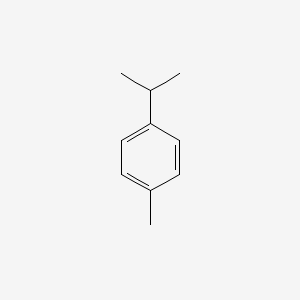| MeSH term | MeSH ID | Detail |
|---|---|---|
| Chemical and Drug Induced Liver Injury | D056486 | 39 associated lipids |
| Dermatomycoses | D003881 | 17 associated lipids |
| Carbon Tetrachloride Poisoning | D002252 | 12 associated lipids |
p-Cymene
P-cymene is a lipid of Prenol Lipids (PR) class. P-cymene is associated with abnormalities such as Abnormal shape. The involved functions are known as Binding (Molecular Function), inhibitors and Oxidation. P-cymene often locates in Cell membrane. The associated genes with p-Cymene are Chromatin, Homologous Gene and ethylbenzene dehydrogenase. The related lipids are Steroids.
Cross Reference
Introduction
To understand associated biological information of p-Cymene, we collected biological information of abnormalities, associated pathways, cellular/molecular locations, biological functions, related genes/proteins, lipids and common seen animal/experimental models with organized paragraphs from literatures.
What diseases are associated with p-Cymene?
p-Cymene is suspected in Abnormal shape and other diseases in descending order of the highest number of associated sentences.
Related references are mostly published in these journals:
| Disease | Cross reference | Weighted score | Related literature |
|---|
Possible diseases from mapped MeSH terms on references
We collected disease MeSH terms mapped to the references associated with p-Cymene
PubChem Associated disorders and diseases
What pathways are associated with p-Cymene
There are no associated biomedical information in the current reference collection.
PubChem Biomolecular Interactions and Pathways
Link to PubChem Biomolecular Interactions and PathwaysWhat cellular locations are associated with p-Cymene?
Visualization in cellular structure
Associated locations are in red color. Not associated locations are in black.
Related references are published most in these journals:
| Location | Cross reference | Weighted score | Related literatures |
|---|
What functions are associated with p-Cymene?
Related references are published most in these journals:
| Function | Cross reference | Weighted score | Related literatures |
|---|
What lipids are associated with p-Cymene?
Related references are published most in these journals:
| Lipid concept | Cross reference | Weighted score | Related literatures |
|---|
What genes are associated with p-Cymene?
Related references are published most in these journals:
| Gene | Cross reference | Weighted score | Related literatures |
|---|
What common seen animal models are associated with p-Cymene?
There are no associated biomedical information in the current reference collection.
NCBI Entrez Crosslinks
All references with p-Cymene
Download all related citations| Authors | Title | Published | Journal | PubMed Link |
|---|---|---|---|---|
| Nakhai LA et al. | Benefits of Zataria multiflora Boiss in Experimental Model of Mouse Inflammatory Bowel Disease. | 2007 | Evid Based Complement Alternat Med | pmid:17342240 |
| Prokopenko OP et al. | [Phenol compounds of cymene and their biological activity]. | 1972 | Farm Zh | pmid:4660471 |
| Rhodes AH et al. | Biodegradation of 2,4-dichlorophenol in the presence of volatile organic compounds in soils under different vegetation types. | 2007 | FEMS Microbiol. Lett. | pmid:17391503 |
| Wu X et al. | Comparative genomics and functional analysis of niche-specific adaptation in Pseudomonas putida. | 2011 | FEMS Microbiol. Rev. | pmid:20796030 |
| Veras HN et al. | Synergistic antibiotic activity of volatile compounds from the essential oil of Lippia sidoides and thymol. | 2012 | Fitoterapia | pmid:22245085 |
| Sindhu S et al. | Chemoprevention by essential oil of turmeric leaves (Curcuma longa L.) on the growth of Aspergillus flavus and aflatoxin production. | 2011 | Food Chem. Toxicol. | pmid:21354246 |
| Zeng WC et al. | Chemical composition, antimicrobial and antioxidant activities of essential oil from Gnaphlium affine. | 2011 | Food Chem. Toxicol. | pmid:21414372 |
| Sarikurkcu C et al. | Essential oil composition and antioxidant activity of Thymus longicaulis C. Presl subsp. longicaulis var. longicaulis. | 2010 | Food Chem. Toxicol. | pmid:20385197 |
| Hyldgaard M et al. | Essential oils in food preservation: mode of action, synergies, and interactions with food matrix components. | 2012 | Front Microbiol | pmid:22291693 |
| Dzhavakhiya V et al. | Chemosensitization of plant pathogenic fungi to agricultural fungicides. | 2012 | Front Microbiol | pmid:22408641 |
| Stel'makh VA | [Comparative evaluation of the toxicity and hazards of orthomenthane hydrocarbons]. | 1985 | Gig Tr Prof Zabol | pmid:4092969 |
| Verma RS et al. | Seasonal Variation in Essential Oil Content and Composition of Thyme, Thymus serpyllum L. Cultivated in Uttarakhand Hills. | 2011 | Indian J Pharm Sci | pmid:22303071 |
| Kumar S et al. | Pharmacological evaluation of Bioactive Principle of Turnera aphrodisiaca. | 2008 | Indian J Pharm Sci | pmid:21369434 |
| Khokra SL et al. | Essential Oil Composition and Antibacterial Studies of Vitex negundo Linn. Extracts. | 2008 Jul-Aug | Indian J Pharm Sci | pmid:20046787 |
| Bisht S and Sisodia SS | Assessment of antidiabetic potential of Cinnamomum tamala leaves extract in streptozotocin induced diabetic rats. | 2011 | Indian J Pharmacol | pmid:22022005 |
| Koti BC et al. | Alcoholic leaf extract of Plectranthus amboinicus regulates carbohydrate metabolism in alloxan-induced diabetic rats. | 2011 | Indian J Pharmacol | pmid:21713092 |
| Zhong W et al. | p-Cymene modulates in vitro and in vivo cytokine production by inhibiting MAPK and NF-κB activation. | 2013 | Inflammation | pmid:23207717 |
| Chen L et al. | Protective effect of p-cymene on lipopolysaccharide-induced acute lung injury in mice. | 2014 | Inflammation | pmid:24085645 |
| Paul LE et al. | Investigation of the reactivity between a ruthenium hexacationic prism and biological ligands. | 2012 | Inorg Chem | pmid:22221272 |
| Singh T et al. | Synthesis, reactivity studies, structural aspects, and solution behavior of half sandwich ruthenium(II) N,N',N''-triarylguanidinate complexes. | 2012 | Inorg Chem | pmid:22148465 |
